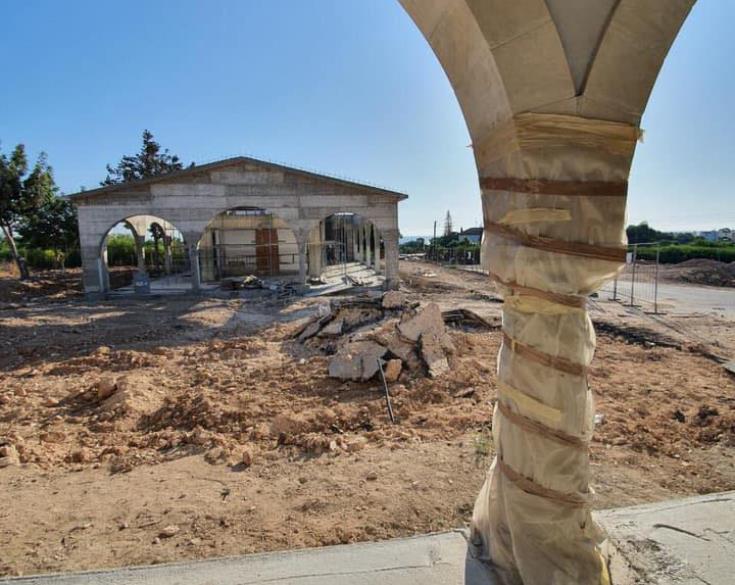Sanctification of Papa Zacharias, the relic of which was recently found in the chapel of Panagiotissa in Paralimni, is suggested by the Diocese of Constantia - Famagusta. The priest was hanged by the Turks in 1573-74,
In his statements to KYPE, the Metropolitan of Constantia - Famagusta Vassilios stated that "because the chapel of Panagiotissa, which is dedicated to the Assumption of the Virgin Mary and is located a short distance from Protaras, needed renovation, it was decided how to proceed with 'blind eyes' to what identify when the project began. According to the recorded history, around the 15th century a deadly disease appeared in Mytilene, which forced a group of people to leave and come together with the priest, Papa Zacharias and to live in the area ".
He added that because there was spring water in Panagiotissa, the Turks around 1573-74 wanted to transport it to Famagusta. However, when the occupiers went to the area, the residents resisted, with the result that the Turks demanded the punishment of all. Papa Zacharias came forward and took responsibility, as a result of which he saved the residents from certain death, but he was arrested, transferred to Famagusta and the next day the Turks returned him beheaded to Panagiotissa.
He also stated that it was known that Papa Zacharias had been buried in the area of Panagiotissa, but without specifying the exact location.
He added that when the renovation works of the chapel began, I asked the contractor to make three sanctuaries instead of the existing one, to make a better foundation for the building and to increase the "solar" that existed. With the excavation that was made for the foundation of the building under the window of the sanctuary, a relic was found, which was buried sitting with its head placed on the knees ".
We estimate, the Metropolitan continued, that “the relic belongs to Papa Zacharias, since at that time the priests and high priests buried them sitting. In this case, with the head of the deceased on his knees, it was obvious that the death came from beheading and we are sure that we found the relic of Pope Zacharias. The relic was given to the Institute of Genetics and Neurology for the necessary research, tests have confirmed that it belongs to the period of 1570 and now we expect them to confirm the cause of death, ie decapitation.
He added that "in the last session of the Holy Synod, at the beginning of September, there was a discussion on how the Church of Cyprus will take part in the celebrations that will take place on the occasion of the 200th anniversary of the Greek Revolution 1821-2021. Among the suggestions was the proposal for the canonization of Archbishop Kyprianou, while I also proposed the canonization of the clergy who were slaughtered during the period of July 9, 1821, that is, 210 clergy and high priests ".
On the occasion of the discussion, Metropolitan Constantias referred to the location of the relic of Papa Zacharias of Panagiotissa, which was hanged at the beginning of the Turkish occupation, and suggested to Archbishop Chrysostomos to present the relevant approval file for approval before the Sanctuary. , with the aim of being sent to the Ecumenical Patriarchate in order to "join as a saint, a martyr of the Church of Cyprus".
He continued with great satisfaction, "the presentation was accepted by the Holy Synod and in fact Archbishop Chrysostomos instructed me to lead a Synodal Committee that will examine all issues related to the issue of sanctification, to compile the necessary files, according to the procedure. , to be given to the Ecumenical Patriarchate, for the final decision of their inclusion in the Hagiology ".
Answering a question, Metropolitan Vassilios said that "we expect that the relic of the owner may be found under the floor of the church, since at that time it was customary to bury the owner inside the church as well as other finds. This area may have a cave and a crypt where we expect other finds to be found. "
He also said that "during the works outside the chapel, a tombstone from the Hellenistic period has been retrieved, probably with an inscription of the last king of Salamis. This has not yet been confirmed by the Department of Antiquities, which took the column for examinations, however, using a special program, the words "king and Nikokreontos" who was the last king of Salamis can be seen.
To another question, the Metropolitan replied that "the first impression is that the soil in the area is the most suitable for burial and it is possible to find not only tombs but also caves. My wish is to study the history of the chapel, something I have already mentioned in the Department of Antiquities, so the excavations will continue to see what else can be found in the area, while it will be clear whether there was an older church there ".
He added that "the Mayor of Paralimni, Theodoros Pyrillis, showed particular interest in what was found in the area and granted two workers of the Municipality to help with the excavations" while expressing his gratitude for the help.
